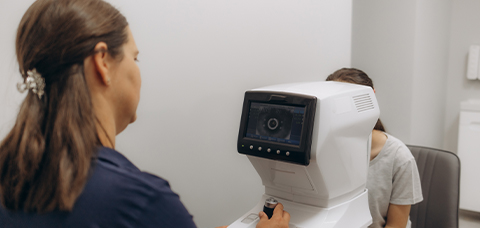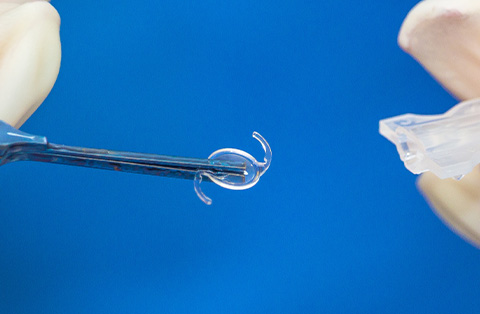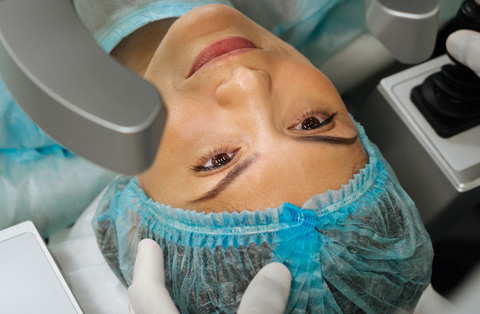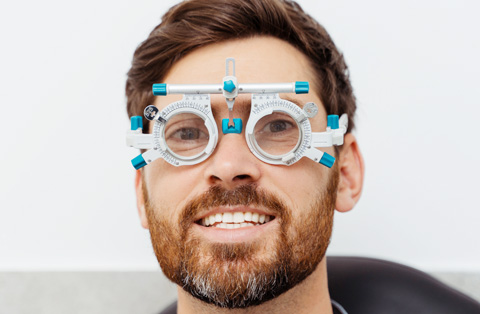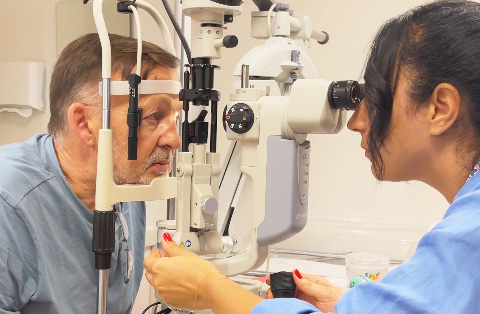Experience sharper vision and faster recovery with Femtosecond Laser-Assisted Cataract Surgery: a safer, more precise solution for removing cataracts and correcting vision with advanced laser technology.
What is Femtosecond Laser-Assisted Cataract Surgery?
Femtosecond Laser-Assisted Cataract Surgery (FLACS) is an advanced method for removing cataracts. Unlike traditional cataract surgery, it uses a femtosecond laser instead of a hand-held blade. This laser creates precise incisions in the cornea and lens capsule. It also helps break up the cloudy lens for easier removal.
This technique improves accuracy. It allows for better control during the operation. It reduces the need for ultrasound energy to break up the lens. That may lead to less trauma to the eye and faster healing.
FLACS combines the precision of laser technology with the proven results of cataract surgery. It is especially helpful in patients who also want to correct astigmatism or have complex eye structures.
How FLACS Differs from Conventional Cataract Surgery?
Femtosecond Laser-Assisted Cataract Surgery (FLACS) differs from conventional cataract surgery in the way the eye is prepared and the lens is removed.
In traditional surgery, the surgeon uses handheld tools to make incisions, open the lens capsule, and break up the cataract using ultrasound energy. These steps rely on the surgeon’s skill and manual precision.
In FLACS, a femtosecond laser performs many of these steps. It creates corneal incisions, opens the lens capsule with high precision, and pre-softens the cataract. This reduces the amount of ultrasound energy needed.
The key differences:
Incision creation: Manual in conventional surgery, laser-guided in FLACS
Capsulotomy: Manually opened in traditional, laser-precise in FLACS
Lens fragmentation: Ultrasound-heavy in traditional, pre-softened by laser in FLACS
Precision and customization: Higher in FLACS, especially useful for astigmatism correction
Tissue impact: Less in FLACS due to reduced ultrasound energy
These differences may lead to better outcomes, especially in complex cases or patients with specific visual goals.
How is Femtosecond Laser Cataract Surgery Performed?
Femtosecond Laser-Assisted Cataract Surgery follows a step-by-step process that combines advanced laser technology with traditional surgical methods.
Steps Involved in Laser-Assisted Cataract Surgery
1. Eye Mapping:
The procedure starts with detailed imaging of the eye. Optical coherence tomography (OCT) creates a 3D map. This guides the laser and ensures high precision.
2. Laser Application:
The femtosecond laser performs three critical tasks:
Makes small incisions in the cornea.
Creates a precise circular opening in the lens capsule (capsulotomy).
Softens and divides the cataract lens into smaller fragments.
3. Lens Removal:
After laser treatment, the surgeon removes the softened lens pieces using a gentle suction method called phacoemulsification. Less ultrasound energy is required compared to traditional surgery.
4. Intraocular Lens (IOL) Insertion:
A new artificial lens is inserted into the eye. This lens replaces the cloudy natural lens and restores vision.
Read more about Intraocular Lens (IOL).
5. Final Adjustments:
The surgeon ensures that the IOL is correctly positioned. No stitches are usually needed. The incisions are self-sealing.
The whole procedure is quick, usually lasting around 15–30 minutes. Most patients go home the same day.
The Importance of Corneal Incision in FLACS
In Femtosecond Laser-Assisted Cataract Surgery, the corneal incision is the first and one of the most critical steps. It allows the surgeon to access the inner structures of the eye.
In conventional surgery, the surgeon creates this incision manually with a blade. In FLACS, the femtosecond laser performs this step with high precision. The laser creates incisions at a pre-determined depth, size, and location based on detailed imaging of the eye.
Why it matters:
Precision: Laser incisions are more consistent in shape and size. This helps maintain the natural structure of the eye and reduces healing time.
Safety: The risk of human error is lower. The laser avoids delicate areas and reduces the chance of complications.
Self-sealing wounds: Properly placed laser incisions often do not require stitches. This helps protect against infection and speeds up recovery.
Astigmatism control: The laser can be used to make additional incisions to reduce mild astigmatism. This improves visual outcomes after surgery.
This step sets the tone for the rest of the surgery. A precise corneal incision supports better lens alignment and clearer vision after healing.
Integration with Phacoemulsification Techniques
Femtosecond Laser-Assisted Cataract Surgery works in harmony with phacoemulsification cataract surgery, not as a replacement. The laser handles the early steps, and phacoemulsification surgery completes the lens removal.
How they integrate:
Laser preparation: The femtosecond laser softens and breaks the cataract into smaller, more manageable pieces. It also creates the opening in the lens capsule.
Reduced ultrasound energy: Because the lens is already fragmented by the laser, the phacoemulsification device needs less energy to emulsify and remove the pieces.
Gentler on the eye: Using less ultrasound reduces the risk of heat and mechanical damage to surrounding tissues, especially the corneal endothelium.
Better outcomes in complex cases: In hard cataracts or eyes with weak zonules, the laser reduces stress during phacoemulsification. This improves safety and efficiency.
This integration combines the accuracy of the laser with the proven reliability of phacoemulsification. It makes the procedure safer and smoother, especially in patients with dense cataracts or anatomical challenges.
What are the Benefits of Femto Laser-Assisted Cataract Surgery?
Femtosecond Laser-Assisted Cataract Surgery offers several benefits. These advantages are not just about technology, but about outcomes that matter to patients.
1. Greater Precision
The laser performs key steps with micron-level accuracy. This ensures better alignment of the new lens and reduces variability between cases.
2. Improved Safety
Laser incisions are consistent and well-placed. This lowers the risk of complications during surgery. The eye experiences less trauma.
3. Less Ultrasound Energy
The laser softens the cataract before phacoemulsification. Less ultrasound means less stress on the eye, especially the cornea.
4. Better Visual Outcomes
Capsulotomy performed by the laser is more centered and circular. This improves how the artificial lens sits in the eye, leading to sharper vision.
5. Astigmatism Correction
The laser can create additional incisions to manage mild astigmatism. This reduces the need for glasses after surgery.
6. Faster Recovery
With cleaner incisions and less trauma, most patients heal faster. Visual improvement often begins within the first few days.
7. Useful in Complex Cases
In patients with hard cataracts, shallow chambers, or weak zonules, the laser reduces surgical difficulty. It offers added safety and control.
These benefits make FLACS a strong option for those who want not only cataract removal but also precise visual correction.
Are There Risks Associated with Femtosecond Laser Assisted Cataract Surgery?
FLACS is generally a safe and well-tolerated procedure. It adds precision to many steps of traditional cataract surgery. However, like all surgeries, it carries some risks.
The overall complication rate is low, especially in experienced hands. Most side effects are rare and manageable. Still, it is important to understand them.
Possible risks include:
Increased cost: FLACS may not be covered by insurance in some countries. This can raise the overall treatment cost.
Capsular rupture: Though rare, the laser or surgical instruments may tear the lens capsule. This could complicate lens placement.
Incomplete laser treatment: In some cases, the laser may not complete all steps. The surgeon must then switch to manual techniques.
Corneal edema: Temporary swelling of the cornea may occur, especially if ultrasound energy is still high.
Infection or inflammation: As with any eye surgery, there is a small risk of postoperative infection or inflammation.
Posterior capsule opacification (PCO): This is a common long-term issue where the lens capsule becomes cloudy. It is easily treated with a laser procedure later on.
Pupil constriction: Sometimes, the laser causes the pupil to shrink. This can make the rest of the surgery more difficult.
In experienced hands, FLACS is a mostly safe and advanced method. But it is not risk-free. Patients should discuss these risks with their surgeon to make an informed choice.
Who is a Candidate for FLACS?
Femtosecond Laser-Assisted Cataract Surgery is suitable for many patients, but not for everyone. The decision depends on the patient’s eye structure, general health, and visual needs.
Good candidates include:
Patients with age-related cataracts: Those looking for a modern and precise method of lens removal.
People with astigmatism: The laser can help reduce mild astigmatism through precise corneal incisions.
Patients seeking premium lenses: Those who want multifocal or toric lenses for better vision without glasses may benefit from the accuracy of FLACS.
Individuals with complex eyes: Patients with small pupils, shallow chambers, or weak zonules may gain safety from the laser’s precision.
Patients who value precision and safety: Especially those who want the most advanced technology available for better outcomes.
Who may not be ideal candidates:
Patients with severe corneal disease or scarring
People with very advanced (mature) cataracts where the laser may not penetrate well
Those with poorly dilating pupils or unstable eye movements
Patients on a tight budget, as FLACS may come with extra cost
Your eye doctor will evaluate your eye health, imaging results, and visual goals. This helps decide whether FLACS is the right choice for you. For many patients, it offers a safer and more accurate surgical experience.
